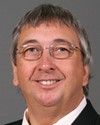Good morning. Thank you, Mr. Chairman.
Mr. Chair and members of the standing committee, ladies and gentlemen, thank you for inviting both General Gosselin and me here today.
As you've heard, I am the chief of military personnel and the champion for official languages for the Canadian Forces.
Today, as I said, I'm accompanied by Major-General Daniel Gosselin, Commander of the Canadian Defence Academy, who reports to me. He is also responsible for CFB Borden.
I would like to first address some strategic issues, then I will ask Major General Gosselin to speak to the Borden situation.
Unlike other federal departments, National Defence is a hybrid of two institutions, the Canadian Forces and the Department of National Defence.
At National Defence, we decided that, to do things right and to comply with the Official Languages Act more fully, we had to make better use of our skills in the other official language and, as a result, to facilitate the establishment of an environment conducive to the use of both official languages. We must also be able to do that while performing our everyday duties, in particular leadership, the provision of services and instruction.
To achieve such results we had to define a new vision that could bring about a significant change in the way we lead, train, administer, and support our members of both official language groups. That vision and its approach are described in the National Defence official languages program transformation model 2007 to 2012. The work started as planned on April 1 of this year.
The transformation model is intended to address the shortcomings that we have marked in our official languages performance. Indeed, these shortcomings have led the Canadian Forces to move away from a positional to a functional approach for official languages purposes.
The goal of the transformation model is to ensure that National Defence personnel are led, trained, administered, and supported in their official language of choice. This focus positions the department and the Canadian Forces to more effectively support domestic and foreign operations, while better meeting their legal official language obligations. It also sets out a practical vision of an integrated military and civilian official languages program.
The transformation model has three aims.
First, to ensure that National Defence's linguistically qualified military and civilian personnel are assigned to the right place at the right time in order to provide effective support for Canadian Forces operations and to comply with the Official Languages Act.
Second, to establish an enhanced Official Languages Act awareness and education program that ensures that civilian and Canadian Forces personnel are fully cognizant of their linguistic rights and obligations.
Third, to establish a performance measurement system that will make it possible to accurately evaluate the ability of National Defence military and civilian personnel to provide, in a coherent and standard manner, leadership, instruction and bilingual services when and where provided for under the Official Languages Act.
The implementation of the functional approach is pivotal to the successful realization of the transformation model. Allow me to explain. Military personnel do not “fill” positions, as sailors, soldiers, and air force personnel are liable to move away from their home, overseas and at home in operations, to serve anywhere at any time and to pay the ultimate sacrifice. They are rotated through various tasks within units to which they are assigned to meet specific and often changing training and operational requirements. This makes for a very mobile and dynamic force manned by very busy people.
Because personnel are often away from home, they do not and cannot, like others, secure a regular presence at any one post. So you can see why the public service positional approach for ensuring bilingual capacity--that is, filling static positions with linguistically qualified incumbents who usually remain in one position until they choose to move to another--cannot work for the Canadian Forces.
That does not mean that the Canadian Forces are not taking any measures to guarantee competency in both official languages, as required by the Official Languages Act. They are doing so, and have been for many years now. They transfer bilingual personnel in order to guarantee that bilingual services and functions are ensured when and where necessary.
This approach is in fact that the National Defence Act requires unit commanding officers to employ their resources, including their personnel, to the best of their ability to perform the missions assigned to them. In the military, the functional approach alone can ensure that personnel are led, trained, administered, and supported in their official language of choice. But first, we must ensure that our work environments themselves are in compliance with the Official Languages Act. To that end, the language of work of every unit of the Canadian Forces is accurately identified as bilingual, English, or French. We then identify what functions need to be conducted in both official languages and in what unit.
The transformation model is an optimistic plan for solving the problems it is important to solve. It is a plan that may last five years. We cannot solve all the problems at the same time.
I believe we're on the right track, however. With the profound and fundamental changes we've undertaken under the transformation model, I must say that the situation today, despite some anomalies, is much different from what it was a few years ago. We have and will continue to make progress.
At this time I'd like to give Major General Gosselin the opportunity to address the members of this committee on the situation at Canadian Forces Base Borden. There are many reasons why the situation in Borden was not addressed in a timely manner. In the end, I make no excuses in front of this committee as to why the situation was not addressed; it should have been. For that, I accept the full responsibility as the current chief of military personnel. Nevertheless, I know full well that the plans that are in place right now will see us realize what we need to do to ensure that the Canadian Forces has the leadership and is compliant with the Official Languages Act.



